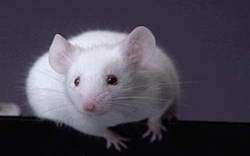October 19, 2012 report
Researchers develop procedure for reducing fear response in sleeping mice

(Medical Xpress)—Researchers at Stanford University have developed a procedure that reduces a fear response in mice. It involves, team lead Asya Rolls said as she presented the groups' findings at this year's meeting of the Society for Neuroscience, injecting a protein synthesis inhibitor into the brain and then exposing the mice to a fear trigger while they sleep.
The research team has been investigating alternative treatments for Post Traumatic Stress Disorder (PTSD) because the current approach, called extinction therapy, has a high rate of relapse. PTSD is characterized by sudden fear when events similar to those that occurred during a traumatic incident occur in ordinary life, causing the person to feel the things they felt during the original experience. Extinction therapy involves asking a patient to intentionally recall the event in a safe environment, over and over until it is no longer terrifying. Researchers have found that while extinction therapy has been shown to be effective in some cases, oftentimes it is not due to the close association between the therapy and the office in which it takes place – triggers in other environments still bring on the fear reaction.
In this new research, the team injected the antibiotic anisomycin into the amygdale – a part of the brain responsible for memory retention – of several test mice and then exposed them to an odor that they had been taught to fear, while they slept. Doing so, Rolls said, reduced the fear response in the mice when they were exposed to the same odor while awake the following day. In comparison, another group of mice that had also been taught to fear the same smell, jasmine, by electric shocks administered to the feet, didn't fare as well when treated with extinction therapy. They showed a greater fear response after treatment and like many human patients experienced relapse when placed in a different cage.
Rolls noted that while the procedure produced promising results, it wouldn't be feasible for use on human PTSD patients – anisomycin has too many side effects and injecting it into the brain just isn't feasible. She suggested other drugs might be found however that could produce the same results, offering hope to those suffering with the disorder.
More information:
Abstract
Sleep to Forget: Unlearning Fear During Sleep
Proof of concept could lead to new treatments for PTSD
According to new work in a mouse model, fearful memories can be reactivated and potentially alleviated during sleep, a finding that could lead the way to more effective treatments for post-traumatic stress disorder (PTSD). The findings were presented at Neuroscience 2012, the annual meeting of the Society for Neuroscience and the world's largest source of emerging news about brain science and health.
The research, presented by Asya Rolls of Stanford University, found that if a fearful memory is linked to an odor, that stimulus could be used to reactivate the memory during sleep without disturbing slumber. Heller and colleagues found that if the reactivation were simply repeated, the fearful memory was exacerbated. But if the reactivation was carried out in the presence of a treatment that blocked the production of protein in the mouse's basolateral amygdala—a brain region involved in fear—the fearful memory was reduced.
PTSD is characterized by strong, highly emotional memories that can be triggered by specific environmental or social stimuli. In a treatment called extinction therapy, a patient repeatedly recalls the memory in a non-threatening environment, such as a therapist's office. But the treatment can become so closely associated with the office that it is not effective when the patient re-experiences the traumatic trigger in a different environment, such as on a street. "Sleep is not linked to any particular place, and therefore the changes made to traumatic memories during sleep may weaken the fear response generally, regardless of where it is subsequently evoked," Heller said. "This could address a major limitation of current PTSD treatment."
In their experiments, the researchers paired an odor with a footshock experience in awake mice. That odor or a control odor was then introduced into the mouse's cage during sleep, and the mice's responses to the odors were tested the next day. Experiencing the conditioned odor during sleep caused an increase in the subsequent fear response. However, if a protein synthesis inhibitor was injected into the basolateral amygdala prior to sleep, the introduction of the conditioned odor during sleep resulted in a reduced fear response during subsequent tests when the animals were awake.
Research was supported with funds from the Down Syndrome Research and Treatment Foundation, the National Institute of Mental Health, and the Klerman Family Foundation.
© 2012 Medical Xpress













